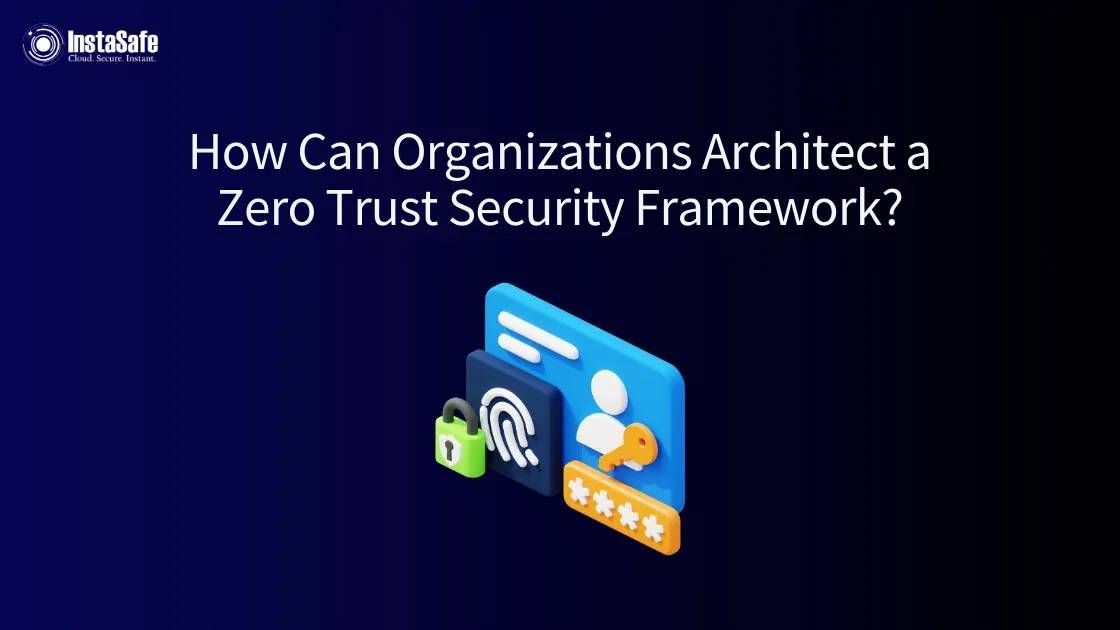How Can Organisations Architect a Zero Trust Security Framework?

Cybersecurity threats continue to evolve in sophistication, pushing organisations to move beyond traditional perimeter-based defences. Zero-trust security has emerged as a powerful approach that assumes no user or system should be trusted by default, regardless of their location or network connection.
Let's explore how organisations can build a robust zero-trust architecture to protect their valuable assets.
Understanding Zero-Trust Security
Zero-trust security operates on a simple yet powerful principle: "Never trust, always verify." Unlike conventional security models that focus primarily on defending the network perimeter, the zero-trust security model verifies every access request regardless of where it originates.
Steps to Implement a Zero-Trust Architecture
Assess Your Current Environment
Before implementing zero trust, organisations must understand their starting point. This means identifying critical assets and data that need the strongest protection. Teams should map existing security tools and capabilities to see what can be leveraged in the new framework.
Documenting current access controls helps identify who has access to what resources while recognising security gaps, which highlight areas that need immediate attention.
Define Your Zero-Trust Vision
Developing a clear vision aligned with your organisation's needs is crucial for success. Meanwhile, setting specific security goals gives the project direction and measurable outcomes.
Organisations must consider their risk tolerance and address any regulatory requirements that apply to their industry. Note that aligning the zero-trust framework with business objectives ensures security supports rather than hinders operations.
Design Your Reference Architecture
Creating a blueprint for your zero-trust security model provides a roadmap for implementation. This design should include all core components and define how they will interact with each other.
Moreover, identifying supporting technologies helps determine what tools will be needed while ensuring the design meets your specific use cases. Overall, it will address your organisation's unique security challenges.
Map Existing Tools to Your Architecture
Determining what can be reused helps create a more efficient implementation plan. Therefore, check existing identity management solutions to see how they can support your zero-trust security goals.
Also, assess endpoint protection capabilities and review analytics and monitoring tools to identify what can be integrated into the new framework.
Identify and Address Gaps
After mapping existing tools, organisations must determine what additional capabilities they need. Prioritising missing components based on risk ensures the most critical gaps are addressed first.
Researching solutions that fill these gaps and budgeting for new technologies prepares your organisation for necessary investments. Further, planning for integration challenges in advance helps avoid unexpected obstacles during implementation.
Implement in Phases
Rolling out your zero-trust security strategy incrementally makes the process more manageable. So, start with high-value assets to provide immediate protection for critical resources.
Implementing identity verification first creates a solid foundation, followed by adding device health verification. This steady approach allows a smooth transition and ensures a stress-free experience for users and IT staff.
Test and Validate
To ensure your implementation works, test it thoroughly. Make sure to conduct security assessments to identify potential weaknesses in the new framework.
Testing access controls verifies that permissions are working correctly, while simulating various scenarios helps prepare for different threat types. In addition, verifying policy enforcement confirms that security rules are being applied consistently across the organisation.
Core Components of Zero-Trust Architecture
Policy Decision Points (PDP)
The PDP serves as the brain of your zero-trust security model. It combines Policy Engine and Policy Administration functions to determine whether access should be granted.
This component evaluates all access requests and applies security policies consistently across the organisation. Moreover, PDPs make the final decision on permission or denial based on multiple factors, ensuring no access is granted without proper verification.
Policy Engine (PE)
As part of the PDP, the Policy Engine calculates trust scores and confidence levels for each access request. It runs trust algorithms that evaluate user identity, device health and behaviour patterns to determine risk levels.
By applying corporate security policies and making context-aware decisions, the PE ensures that access is only granted when all security requirements are met.
Policy Administration (PA)
The Policy Administration component enforces decisions made by the Policy Engine. It sends commands to enforcement points throughout the network and creates session-specific tokens or credentials for authorised users. The PA manages communication paths between users and resources, ensuring that all connections follow the established security protocols.
Policy Enforcement Points (PEP)
PEPs act as security guards for your resources. They control access to systems and data by enabling, monitoring and terminating connections based on security policies. Following directions from the Policy Administrator, PEPs protect resources in different network locations, creating a consistent security barrier around all organisational assets.
Policy Information Points (PIP)
PIPs gather critical security information from various sources to inform policy decisions. They collect telemetry data from security tools and gather logs from supporting systems to provide context for better decision-making.
This information helps the Policy Engine make more accurate access decisions and supports dynamic policy adjustments as security conditions change.
Why Choose Zero Trust Security Model?
Reduced Attack Surface
A zero-trust security model significantly shrinks the attack surface by limiting user access to only what's needed for their role. Each resource is protected individually rather than relying on a single network perimeter.
This approach means that even if one system is compromised, attackers cannot easily move to other parts of the network. The least privilege principle ensures users only have access to what they need, which reduces potential damage from both external attacks and insider threats.
Improved Visibility and Control
Zero-trust architecture provides much better visibility into who is accessing what resources across the organisation. Security teams can see exactly which users and devices are connecting to which systems and data.
This detailed view helps identify unusual patterns that might indicate a security breach. With continuous monitoring of all access attempts, organisations gain real-time insights into their security posture and can quickly respond to attacks before they cause any damage.
Better Protection for Remote Work
The shift to remotely working has made traditional perimeter-based security obsolete. A zero-trust framework is location-agnostic, applying the same security controls regardless of where users connect from.
Remote employees undergo the same verification process as those in the office, ensuring consistent security across all work environments. This protects company resources even when accessed from personal devices or public networks, making it ideal for today's distributed workforce.
Enhanced Compliance Capabilities
Many regulations require organisations to control and monitor access to sensitive data. The zero-trust security model inherently supports these requirements through its focus on identity verification, access control and continuous monitoring.
Organisations can more easily verify compliance with standards like GDPR, HIPAA and PCI DSS because they have detailed records of who accessed what data and when. This documentation simplifies audit processes and helps avoid compliance-related penalties.
Adaptability to Evolving Threats
The zero-trust security framework is designed to adapt to changing threat landscapes. Rather than relying on static defences, it continuously evaluates risk based on current conditions. This approach improves its ability to handle new attack methods and tactics.
Organisations can update security policies centrally and have them applied automatically across all resources, which ensures that protection remains effective even as threats evolve.
Zero-Trust Architecture: Common Implementation Challenges
Unclear Planning
Zero-trust security often fails due to rushed implementation without clear goals. Many teams don't assess their current security posture first, leading to misaligned strategies and wasted resources.
Budget Limitations
A complete zero-trust security model requires significant investment. Many organisations face budget constraints, which force difficult compromises in their security architecture.
Legacy System Compatibility
Older systems were not designed with zero-trust principles in mind, and legacy applications lack modern authentication capabilities. These limitations create stubborn roadblocks during implementation.
Integration Difficulties
Zero-trust requires multiple security tools to work together seamlessly. It is challenging to get diverse solutions to communicate properly, which delays implementation and creates security gaps.
Expertise Shortage
Many IT teams lack specialised zero-trust knowledge. This skills gap leads to configuration errors. Incomplete deployment creates vulnerabilities that attackers can exploit.
User Experience Balance
Security measures often impact productivity. Organisations struggle to protect assets while keeping work efficient. Finding the right balance remains an ongoing challenge.
Conclusion
By understanding the core components, implementing them in phases and addressing common challenges, organisations can create a robust zero-trust architecture that secures their most valuable assets.
Remember that zero-trust architecture is not about trusting anything—it is about verifying everything before extending trust. This approach provides the foundation for secure operations in today's complex and distributed business environment.
At InstaSafe, we make security simple: verify everyone every time. No more complex passwords or VPNs — just secure access from anywhere, on any device. Our Zero Trust solutions protect your network and applications without slowing down business. We make sure that your threats stay out and your team stays productive.
Frequently Asked Questions (FAQs)
How do you build a Zero-Trust architecture?
Build zero-trust by implementing continuous verification, least privilege access, micro-segmentation, strong identity management and encrypting all traffic regardless of location or network boundary.
Which architectural component enables a zero-trust security model?
Identity and access management (IAM) is the main component, enabling contextual authentication and authorisation for all users, devices and resources.
How to implement zero-trust in an organisation?
Start with asset inventory, implement strong identity verification, apply for least privilege access, use micro-segmentation, monitor continuously and gradually phase out legacy systems while maintaining business continuity.
What are the 5 pillars of Zero-Trust architecture?
- Identity verification
- Device security
- Network segmentation
- Least privilege access
- Continuous monitoring and validation
